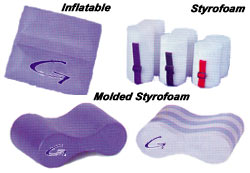Pull Buoys
How To Use. Using one is simple. Just put it between your mid to upper thighs and swim. You will have to keep your legs together to keep the buoy in place and will, therefore, be unable to kick normally. Although kicking is still often possible, you should refrain, since you defeat the purpose of using it by cheating. Just let your legs float along and enjoy the ride. And, if it seems awkward at first, hang in there, you'll get used to it.
If you find them hard to hold onto or you cannot help yourself from kicking while using them, them you can accompany the buoy with surgical tubing or other rubber tubing wrapped around your ankles to keep them snugly together. This may help to weigh down the legs so a more buoyant buoy may be needed to keep those legs from sinking.
Types. Pull buoys come in all shapes and sizes. The most common material used to make pull buoys is Styrofoam. The most common type of pull buoy has two Styrofoam cylinders attached with thin nylon rope or strap looped through two holes in each cylinder. The rope is adjustable so that the swimmer can adjust the space between the two cylinders to fit their legs just right.

Why They Are Good. As mentioned above, they are great for isolating your pull. They help to strengthen your upper body and arms by eliminating the kick propulsion, while keeping your lower body elevated in the water enough to keep good swimming posture.
Not only does the swimmer benefit from the increased strength training of the upper body, but she receives the added benefit of resting her legs, which is great for triathletes. Studies have shown that only 10-15% of the forward propulsion in swimming is derived from the legs. A little more is gained when sprinting and a little less when swimming distance events. The legs are primarily used to stabilize and streamline the body. In comparison to swimmers, triathletes tend to use their legs much more. This causes them to train in the pool with legs that are usually much more broken down and tired than the upper body. Kicking in the pool will often augment the fatigue without helping much with performance.
As a result, buoys can provide a couple nice benefits to athletes who use them to complement their normal workout (don't use them all the time!):
- they let the legs rest and recover while continuing to train the rest of the body for swimming
- they allow the athlete to maintain a good steamlined position
- they allow the triathlete to simulate swimming the race with a wetsuit (wetsuits provide extra buoyancy)
In sum, a pull buoy is a valuable training tool for swimmers and especially for triathletes. Find one that looks cool and is comfortable for you. Then, use it in your training, and you should not only see some good results, but you should also break up the training monotony which can make training Boring--with a capital 'B'.